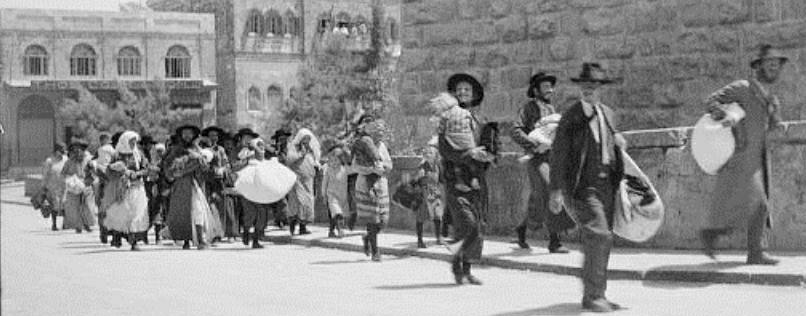Pages in Section 4

Real Trouble at the Western Wall, 1929
ii. The Hebron Massacre
iii. The Rest of Palestine in 1929
According to Dr Hillel Cohen, of the Hebrew University of Jerusalem, 1929 was the year when Arab and Jewish narratives drifted apart.
There had been riots and disputes between the two sides for many years, even before the Balfour declaration, but until 1929, the established majority Arab community and the rapidly increasing Jewish minority had lived in relative harmony. For reasons that are hotly contested, in 1929 violence erupted in several cities and in the process of mutual blame and recrimination, each side began to develop its own history – separate narratives which have continued to drift further apart ever since.
 The violence started when trouble at the Western Wall of the Temple Mount (kotel) erupted. It couldn't have come at a worse time for the British. Most of the top-ranking police officers and a goodly proportion of other ranks were out of Palestine on home leave as were the high commissioner and district governors. Only 90 British police were left in Palestine under the command of Deputy Inspector-General Major Alan Saunders OBE.
The violence started when trouble at the Western Wall of the Temple Mount (kotel) erupted. It couldn't have come at a worse time for the British. Most of the top-ranking police officers and a goodly proportion of other ranks were out of Palestine on home leave as were the high commissioner and district governors. Only 90 British police were left in Palestine under the command of Deputy Inspector-General Major Alan Saunders OBE.
On August 14th 1929, the eve of the Jewish Holy Day of Atonement commemorating the destruction of the first and second Temples, about 6000 Revisionist Zionists assembled in Tel Aviv to protest against infringements of Jewish rights at the Western Wall. Many travelled on to Jerusalem and next day marched with a police escort to the wall, waving flags, leaflets and singing Hatikva. The following Friday, 2000 Muslims marched to the wall and desecrated Jewish Holy Books. The acting High Commissioner, Harry Luke, put the armoured Transjordan Frontier Force stationed in Transjordan on the alert.
The next day, the Jewish Sabbath, a young boy was stabbed. He died on the following Tuesday. The British Police had to use force to keep order at his funeral near Jaffa Gate and the Main Post Office.
Saunders assumed command of the whole Jerusalem district and placed acting district commander Harrington in charge of the Old city. He put the commander of the police school, Kingsley-Heath in charge of the New City. The British section of the Police prepared for riots but because of their low numbers had to rely on the Palestinian section, most of whom were Arabs.
On Friday 23rd tens of thousands Arabs charged into Jerusalem and assembled for morning prayers carrying makeshift weapons. Jews, anticipating the worst, fled from the Old City
Kingsley-Heath ordered his men to confiscate the Arabs' weapons.
Saunders met the Mufti before noon, The Mufti promised his people would not break the law unless provoked.
About 12.30 a frenzied Arab mob burst out of the gates of the old city. Luke, from his office near Damascus Gate, ordered the armoured unit stationed in Ramleh to move to Jerusalem. Kingsley H-Heath and his men kept most of the mob from charging into the Jewish areas but some managed to reach the Montefiore Quarter and attack the Jewish residents there.
Luke sent a cable to London demanding the immediate dispatch to Palestine of an infantry battalion and another cable to the Royal Navy command in Malta for similar reinforcements. By 4 pm 70 British male civilians, including 28 visiting theology students, were mobilized as special constables.
Next day another 188 British men enlisted and Luke telephoned the Acting High Commissioner in Egypt for help. Several platoons of the British Brigade flew from Cairo to Atarot and Brigadier Dobbie arrived by train with the rest of his battalion the following day.
For the people of Hebron, however, these military forces arrived too late.